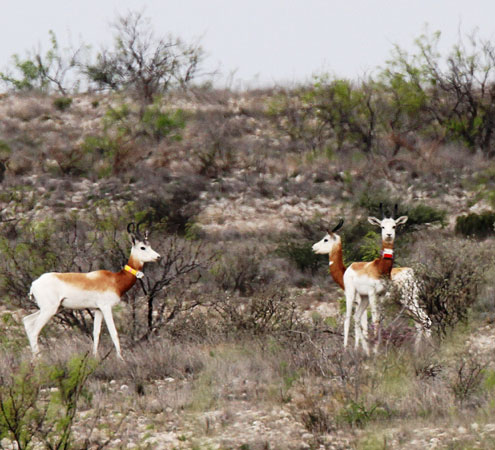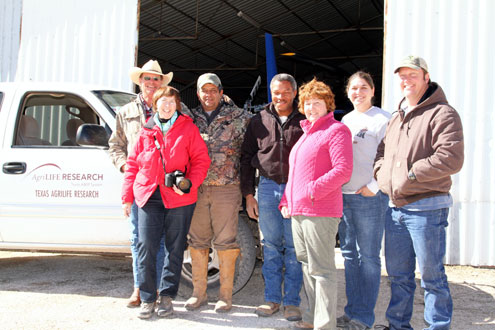UVALDE – How do you track dama gazelles across more than 20,000 acres of Texas range to gather insights to help ensure their survival here and in their native Africa?
To answer that question, Dr. Elizabeth Cary Mungall, science officer for the Second Ark Foundation and adjunct professor at Texas Woman’s University, contacted Dr. Susan Cooper, a Texas A&M AgriLife Research wildlife scientist at the Texas A&M AgriLife Research and Extension Center in Uvalde.
Last year, Cooper was asked by the foundation to provide her technical expertise, gained from tracking white-tailed deer in South Central Texas, to help track the movements of dama gazelle bucks roaming the Stevens Forest Ranch in West Texas.

“Here at the center, we have been using GPS tracking collars on white-tailed deer to conduct research on how their use of habitat changes in response to different land management practices, as well as their interaction with other animals, which is relevant in potential disease transfer,” Cooper said. “We’ve fitted GPS collars on more than 100 animals for investigation purposes, including deer, cattle, raccoons, bobcats, coyotes and feral hogs.”
She explained that the collars have a GPS unit built into the top and a battery box on the bottom, along with an antenna built into one side of the collar. On the other side there is a built-in timed drop-off unit that releases the collar automatically after a set time.
“This eliminates the need to recapture the animal to retrieve the collar at the end of the study,” Cooper said. “The transmitter collars are commercial tracking collars, but for the gazelle study the collars were colored so that each animal can be easily identified by its bright necklace.”
The Uvalde center was able to provide five units for use in the dama gazelle research. The collars were programmed to record the location of the animal once every three hours for an entire year. Cooper and her team will overlay gazelle locations on maps showing terrain and soil types to help determine the habitats and likely vegetation dama gazelles prefer as they move across the range.
“We knew exotics were a departure from the lab’s usual routine, so we were glad to have a chance to explain the importance of GPS-collaring the dama gazelles here in Texas for the survival of this North African species,” Mungall said. “We chose the bucks for collaring because they travel so widely and have been harder than the female groups to observe for extended periods of time. We want to find out where they go, when they go and how this relates to the seasons.”
Mungall said the Second Ark Foundation and the Exotic Wildlife Association have been particularly interested in studying the dama gazelle in Texas. This is in part because this species has been more difficult to establish in the state than other exotics, such as the scimitar-horned oryx, which has a similar native habitat, and the Indian blackbuck antelope – a relative of the gazelle. The two organizations have been working closely to investigate dama gazelle basic biology and range use in Texas, including Mungall’s year-long study that began last fall.
The dama gazelle is considered “critically endangered” on the International Union for Conservation of Nature Red List for Threatened Species, and recent estimates indicate only about 300 remain wild in their core habitat of the Sahel on the semi-desert southern fringe of the Sahara.
While they once could be found in great numbers across northern Africa, they are now found only in isolated areas of the north central African countries of Chad, Mali and Niger. A 2012 account by individuals studying the species in Africa estimates only one or two populations there with enough dama gazelles – about 20 – to be self-sustaining.
However, Mungall said, there are currently about 800 dama gazelles roaming around Texas ranches.

“The dama gazelles in Texas are realistic candidates for reintroduction into their native areas as well as ideal safeguards against extinction in the wild, since all of them originally came from Africa” she said. “Once we learn how they use their range in Texas, we can apply this information to help the species both here and during any possible future restocking efforts to bring them back to their native African habitat. This data will help land managers better estimate breeding patterns and the population numbers that can be supported under various conditions.”
To conduct her dama gazelle space-use research, Mungall contacted Stevens ‘Steve’ Forest, owner of Stevens Forest Ranch near the West Texas town of Dryden, who agreed to let her and her team study his population of about 100 dama gazelles on his approximately 26,000-acre property.
Animal location and capture and collaring began in January. The bucks were captured by using a helicopter, flown by Forest himself, and a spotter with a tranquilizer gun.
To collar the animals for the study, Cooper and Shane Sieckenius, an AgriLife Research assistant, and Andrea Silva, an AgriLife Research technician, also from the Uvalde center, accompanied Mungall and her team to the ranch. Cooper and Sieckenius fitted the collared bucks with differently colored GPS collars, and other team members measured their horns to approximate the age and size of the buck. The bucks were then set loose to return to roaming the range as they normally would.
“The GPS collar space study will help us determine how much space is enough so that a self-sustaining population can include multiple adult males,” Mungall explained. “It will also help answer the question of the size of a male’s normal home range under unrestricted Texas conditions. In addition, it will help us find out whether home ranges overlap and, if so, whether males use the overlap zone at the same time or at different times.”
She said in the Hill Country of Central Texas, where the raising of exotic hoofed stock is a major ranch and tourism activity, experience with dama gazelles has shown that mature males often end up in lethal fights, and that a herd male will harass and possibly kill maturing males if they cannot leave the same general range space.
“As a result, the standard Hill Country model is to keep only single-male herds,” she said. “But this study will help us determine if this is the best model to use or if there are other possibilities for managing and increasing the species.”
Mungall and her team, which often includes her husband Christian who serves double duty as a photographer, engage in monthly tracking sessions using an antenna and radio receiver. This assures them that the collars are functioning properly and are still on the animals, plus verifies the collared animals are still alive and healthy. Cooper typically participates in these monthly trackings.
“This project would have never gotten off the ground without Susan and her team,” Mungall said. “Susan’s years of experience with these GPS collars has helped us understand the GPS readings and has given us insights into the use of this equipment that you just can’t get by reading an operations manual.”
Mungall noted that during her monthly visit to the ranch in March, she and her team were able to locate all the collared bucks and they “all looked healthy, with apparently no change in activity between collared bucks seen together and collared bucks in groups with other dama gazelles.”
During the most recent visit in April, the group looked for differences in dama gazelle location due to seasonal changes.
“Although the bucks will be harder to spot with the increase in foliage during the spring green-up, we’ll still be able to locate them by homing in on the tracking beacons built into the GPS collars,” Mungall said.
Mungall said she is pleased that word is spreading on the research being done toward preserving the dama gazelle.
“Fossil Rim Wildlife Center in North Central Texas just notified us they will make a contribution to this year’s portion of the project,” she said. “This is great news, and we’re excited that more people are learning about our work and are interested in helping support it.”
Fossil Rim Wildlife Center is an endangered species research and conservation center near Glen Rose with more than 1,000 animals representing 50 species.
“This new funding sponsor, Fossil Rim Wildlife Center, joins the Texas Hill Country Chapter of Safari Club International, Safari Club International Austin Chapter and Kevin Reid of Morani River Ranch, who incorporated the dama gazelle study into the ranch’s conservation programs when the collaring was first proposed, in supporting this worthwhile project,” Mungall said.